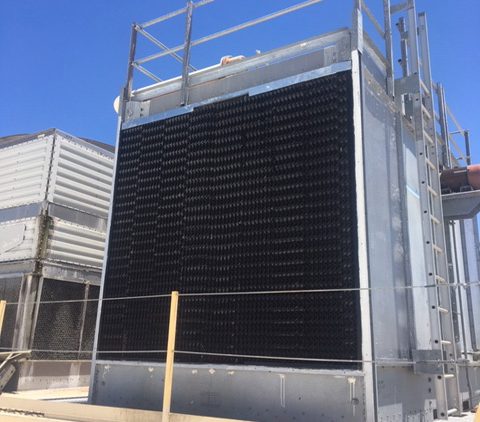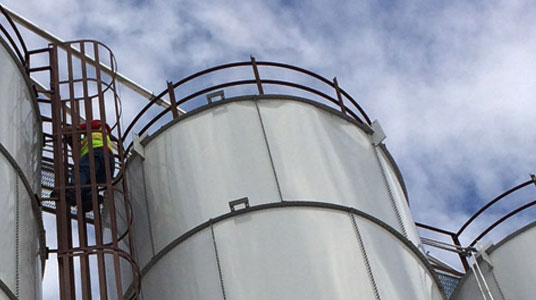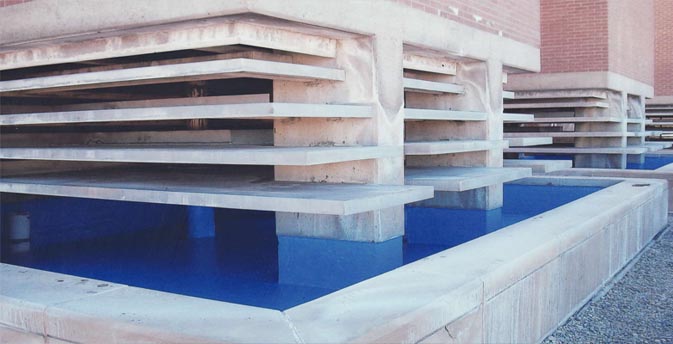Industrial water chillers are used in a diverse range of applications where chilled liquid or water are circulated through processing equipment. Most frequently utilized to cool machinery and products, they are also used in die and tool cutting, chemicals, machine tool, lasers, semiconductors, injection molding and more. An industrial chiller works by moving heat from one place to a different location. Often a solution of glycol and water is used to transfer the heat back and forth from the chiller and that may necessitate a pumping and reservoir system. A sufficient cooling system is essential to your level of productivity.
Water Chiller Definition
According to Brighthub Engineering, a water chiller is a vital part of an HVAC system. It works by removing heat from the system by dehumidifying and cooling the air. The two types used in an HVAC system are the mechanical type and the absorption type. The mechanical chiller system has a condenser, evaporator, compressor as well as other controlling devices. The absorption chiller system used an absorber and generator as opposed to a compressor. You can learn more about this process here.
How Do Chillers Work?
In most cases, a pumping system is used to circulate cool water or a glycol/water solution to the process from the chiller. Cool fluid removes the warm fluid and the heat is transferred back to the chiller. Chillers contain refrigerant, a compound that differs depending on the application but they work on the same principle we have just described. This is known as the refrigeration cycle. The refrigeration cycle commences with a low-pressure liquid/gas mix entering into the evaporator.
The heat from the process water or water/glycol solution boils the refrigerant, changing it from a low-pressure liquid to low-pressure gas. The low-pressure gas enters the compressor and then becomes high-pressure gas. The high-pressure gas enters the condenser where condenser water or ambient air removes heat to cool it to a high-pressure liquid. The high-pressure liquid moves to the expansion valve, controlling how much liquid refrigerant enters the evaporator, starting the refrigeration cycle once again.
Chillers use two kinds of condensers, water-cooled and air-cooled. In a water-cooled condenser, water from a cooling tower cools and condenses the refrigerant. An air-cooled condenser uses ambient air to cool and condense the hot refrigerant gas back down to a liquid, ultimately rejecting the heat from the chiller to the air. You can learn more about water chillers here.
Types Of Chillers
There are 3 types of chillers that cool things using air, water, and evaporation. Each type may have subcategories based on how each of them accomplish this goal. Technology varies and depending on the age of the building you own or manage the type of chiller you have may fit into one of the following categories.
Air Chillers
Air chillers can be split in various configurations or used as a single piece unit. Air chillers vary in size from small capacity to 100+ ton models that are used to cool commercial buildings. The difference between air cooled and water-cooled chillers is that air chillers use ambient air as the condensing source and a fan that moves the air over the coil. Water chillers on the other hand use water as the condensing source and a pump that circulates water through the condenser out to the cooling tower that releases it into the atmosphere.
Water Chillers
Water chillers are mechanical devices/refrigeration systems that are used to dehumidify air and cool fluids in industrial and commercial facilities. They have many applications from process use to space cooling. The difference between water and air chillers is that the water is sent to a cooling tower to cool the water in a water chiller.
Evaporative Condensed Chillers
An evaporative condensed chiller is an alternative to water and air condensed chillers. Most evaporative condensed chillers range from 15-200 tons but one should select a system that is best suited for their individual facility. Maximizing heat rejection in evaporative chillers is done by recalculating the water constantly to provide on-going wetting of the condenser tubes while mechanical fans pull the air over them, which evaporates the water and rejects the heat to the atmosphere.
Sub-Categories Of Chillers
These chillers are sub-categories of the main 3 types of chillers: reciprocating, rotary screw, and absorption chillers. Each have their own design and pro vs. cons. Choosing the right chiller for your facility is an important decision. It will decide how well you are equipped to take care of your industrial process or use the chiller as part of your HVAC system in a commercial building.
Reciprocating Chiller
Gas is compressed inside these types of chillers with pistons, not unlike a car engine. There are multiple pistons that continue to compress the gas to heat it. The difference is that the hot gas is used inside the system, not simply exhausted out of a tailpipe. The demand is matched by the adjustable intake and exhaust valves that can be opened to allow the piston to simply idle. Idling the piston when demand for chilled water helps manage capacity. This system is very flexible and can cope with the specific demands from load on the system. It is also possible to manage the capacity to match the demand with a hot gas bypass, but it is not considered to be as efficient. Some systems use both capacity control systems which unload pistons but also utilize the hot-gas bypass to match demand.
Rotary Screw Chillers
The screw compressor is also known and a helical compressor. Inside the stationary housing it contains to mating helically grooved rotors. Direct volume reduction is achieved when the helical rotors rotate. The capacity of a rotary screw compressor varies between 20 and 450 tons and is controlled by a sliding inlet valve or variable speed drive.
Centrifugal Compression Chillers
One of the main features of the centrifugal compression chiller is that they offer a high cooling capacity in a compact design. They operate via an impeller, much like a water pump. The impeller compresses the refrigerant. These chillers can be outfitted with both variable speed drives and inlet vanes which are used to regulate the control of the chilled water capacity. These are high capacity and can handle 150 tons and up.
Frictionless Centrifugal Chillers
Much like the regular centrifugal design these operate via the same principles but do so with magnetic bearings. The use of magnetic bearings eliminates the need for lubricant and features variable speed DC motors. These motors are typically direct drive and attached directly to the chillers. The capacity of these chillers range anywhere from 60 to 300 tons.
Absorption Chillers
Instead of utilizing a mechanical compressor the absorption chillers use a heat source to be the driving force behind the refrigeration cycle. These chillers typically use two liquids, one to cool and one to absorb. The absorbent liquid is usually ammonia or lithium bromide, and the coolant is usually water.
The two liquids are separated and recombined during the absorption cycle. Due to the low pressure conditions in the chiller water can change phase easily. Water and the absorption liquid also perform well in chillers because of their natural properties of affinity.
The refrigeration cycle starts with the heating of the combined liquids. This boils the water out of the absorption liquid at a high pressure. The next step is sending the refrigerant water vapor past a condenser coil where the heat is rejected and the water vapor is phased into a high pressure liquid. Then the high pressure liquid is passed along to the lower pressure evaporator where adiabatic flash evaporation returns the water to a gas. This absorbs the heat from the water that needs to be chilled. The last step is the concentrated absorption liquid is sent back to be recombined with the lower pressure water vapors coming from the evaporator.
Where Are Chillers Used?
In the industrial world there are millions of machines which generate incredible heat. For these machines not to overheat and melt themselves they must be cooled. This is what a chiller is designed to do. Chillers are used for processes that operate at 60°F or lower. For processes which operate at 85° or higher cooling towers are a better fit. Listed below you’ll find some of the common areas in which chillers are used:
HVAC Systems
Cooling systems are more than just a matter of comfort in Arizona, they are matter of health and safety. For commercial locations cooling expenses typically make up about 30% to 50% of the energy costs. With the cost of electricity always on the rise and the phasing out of HCFCs and CFCs there is an incredibly high demand for replacing large commercial air conditioning and refrigeration systems with chilling systems.
Plastic Fabrication
Chillers used in plastic fabrication typically take on one or both of two roles, cooling the plastic products and cooling the machinery used to make them. The products which are blown, stamped, or extruded. The chiller units are also used to keep the barrel of the extruder, and hydraulics of the molding machine cool. This not only saves on energy but it also helps extend the life of the plastic fabrication equipment.
Medical Facilities
Medical facilities, especially those which do MRIs, laboratory testing, scanning, and blood cooling all rely on chillers to get the job done. The scanning equipment such as MRI machines produce a lot of heat that must be dissipated quickly and safely to preserve the condition of the equipment.
Printing Houses
Chiller play a critical role in high volume printing houses. There is a lot of heat generated by friction through the printing rollers and as ink is dried in ovens. To keep the rollers in good condition and freshly printed paper in good condition chillers are used. They remove the heat from the process and keeps the parts and paper in good condition despite the high heat conditions.
Beverage Industry
A common step of many types of beverage production is cooking, mixing, and pasteurizing. Whether its soda, beer, milk, or other drinks the beverage industry relies on chillers to remove heat produced by these processes.
Laser Applications
Lasers are fast becoming a more common element of production, and one that produces a lot of heat. To keep the lasers and products they cut cool chillers are integrated into these systems.
Rubber Fabrication
The rubber industry relies on chillers to cool the multizone water temperature control units. This keeps the rubber mill, rubber extruder barrel, bambury mixers and calendars cool and working properly.

Phoenix Valley Chiller Maintenance
Chiller Maintenance keeps equipment in good condition, operating more efficiently, and saves money by using less energy. All Kote Lining, Inc. offers chiller maintenance and repair to the Phoenix Valley. We keep chillers and cooling towers operating at their highest possible performance. Refurbishment is one of our services which saves companies and municipalities significant operating costs in comparison to needing cooling tower or chiller replacement. Get in touch with All Kote Lining, Inc. to learn more about what we can do for your chillers and cooling towers.
Call 480-966-4446 or Contact Us





